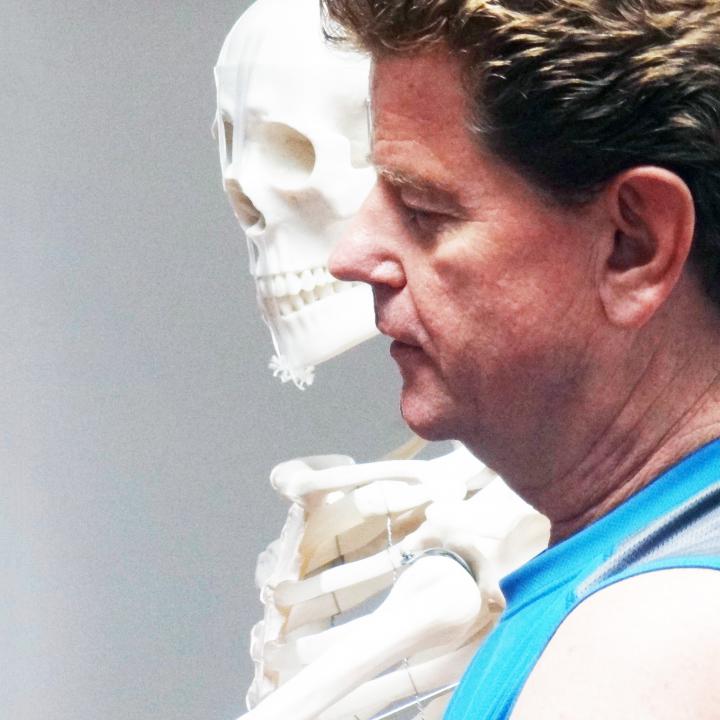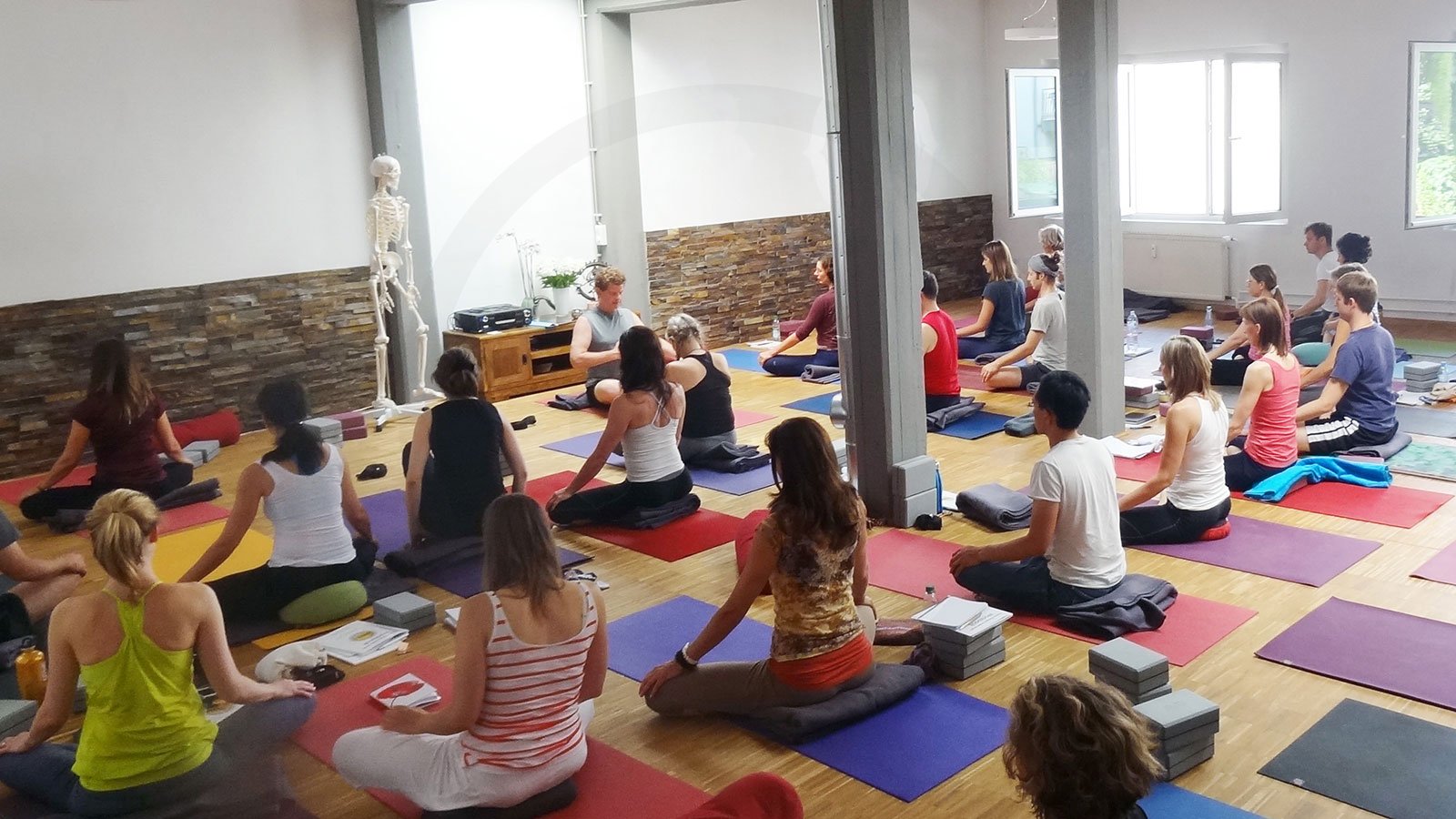Yoga Therapie Teacher Training Doug Keller
Anmeldung
Alle Preise inkl. der gesetzl. MwSt.
Discount
Spare bei Anmeldung und Bezahlung als Frühbucher bis zum 01. Juni 49 € (Normalpreis 499 €). Für Absolventen/innen unserer YTT200/300 Ausbildungen und für unsere Mitglieder gilt der Frühbucherpreis bis Ende Juli – vorausgesetzt es wird mit Lastschrift / Überweisung gezahlt.
Doug Keller kommt auch im Sommer 2017 wieder nach Stuttgart und ihr dürft euch wie immer auf vier intensive Tage und fundierte Erkenntnisse aus der Welt des therapeutischen Yoga freuen.
Die Schwerpunkte des diesjährigen Intensiv Teacher Trainings mit Doug sind:
- Donnerstag: Der Kopf als „Fundament“ / Scoliose
- Freitag: Die myofascialen Linien der Arme
- Samstag: Beweglichkeit durch gezielte Kräftigung / Hamstrings / Knie und Füsse
- Sonntag: Stabilität zur Vermeidung von Schmerzen und Verletzungsrisiken
Die Yoga Therapie Fortbildung umfasst 24 Stunden.
Die geplanten Zeiten sind jeweils 09:00 - 12:00 und 13:30 - 16:30 Uhr.
The Therapeutic Wisdom of Yoga: Rewriting the Story of Our Health and Growth
We’ll begin with the neck and shoulders, focusing on upper body and spinal health, with an additional focus on working with scoliosis. The principles we will cover for working with asymmetries in the body will be helpful to all, since asymmetries that lead to muscular and joint problems are nearly always present, whether one has a scoliosis or not. This will be an insightful look that will add new dimensions to practice, including the pairing of intentional breathing to realignment actions in asana.
From there we will expand into a treatment of the health of the whole body, and in particular the low back, sacrum, hips, knees and feet. The central focus will be on ‘movement impairment syndromes’ - patterns of movement closely connected to pain problems as well as joint and muscle injury.
This approach to pain problems is especially suited to yoga, and will provide teachers and practitioners with a vital toolbox for recognizing and assessing these patterns, and designing an approach through specifically targeted asana practice and remedial exercises aimed at changing them for the better.
Each day will begin with a practice, which will give everyone a chance to experience how the principles being covered might be introduced simply in the class setting of an asana practice. The training in the afternoon will include some hands-on experience both in learning how to recognize postural and movement patterns for working with students or clients more individually — and for learning to make effective adjustments.
A theme throughout the training will also be to weave in elements of pranayama in relation to health, including the development of the idea of the ‘Vayus’ which began in the Upanishads but were only elaborated in later hatha yoga texts, principally the Gheranda Samhita.
Exercises that energize the Vayus will add a new dimension to pranayama practice, and also can be incorporated into asana practice (which will be done throughout the training). Each day will include work with the Vayus, pranayama and Yoga Nidra — including discussion of the principles behind each practice, and some historical background from hatha yoga texts.
All in all, the training will be an exploration into the many dimensions of wisdom that the ever-evolving practice of hatha yoga has to offer to us as body, mind and spirit work to maintain health and grow in heart in the face of the many challenges — including pain, injury and dysfunction — that life throws at us.
Donnerstag, 27. Juli
‘The Head is the Foundation’
Traditionally we think of the foundation of the body — in yoga and in our posture in life — in terms of the foundation set by the feet (and how the bones are ‘stacked’ above it). But we can also look at freedom and spaciousness in posture and movement in terms of the placement and movement of the head upon the spine, with the maxim, “As above, so below.” The guiding principle will be the yogic insights behind the ‘bandhas’ — Jalandhara bandha in particular.
This session will focus on alignment and actions of the head and neck, combined with stabilization of the ‘Core,’ with special emphasis on stabilization in twists and head rotation — and how this attention to strengthening and the release of tension can bring greater freedom and better alignment in the rest of the body, particularly in the low back, sacrum and hips.
Insights into — and to be learned from — Scoliosis
The afternoon will introduce an understanding of the asymmetries — side-bends and rotations of the spine that affect the rib cage, neck and shoulders — that are typical of scoliosis and which are also present to a much lesser degree in many of us who do not have scoliosis, but experience pain and difficulties from more subtle versions of these asymmetries.
This will include practical tools for making assessments, along with tools of practice that can be taught to students so that they can learn to be self-correcting, throughout the day as well as in their asana and breath practice.
This topic will lead us into basic principles of shoulder alignment combined with the breath and actions for the neck. We will cover all of the planes of movement for the shoulders in asana practice, which will be carried over into the next morning’s asana practice.
Freitag, 28. Juli
The Myofascial ‘Sutras’ of the Arms
The work with the upper body from the first day will be carried over into the practice and into a deeper exploration of the myofascial lines or ‘sutras’ that govern the actions of the arms — the lines of larger muscles that govern the movement of the shoulder blades and give the arms their power, as well as the deeper lines of muscles that govern rotations and are crucial for the health of the rotator cuffs, elbows and wrists. We will cover actions, ‘openings’ and stretches in non-weightbearing poses, as well as the challenges — and benefits — of poses in which the arms bear weight. Additional connections to scoliosis and asymmetries in the shoulders will be made, with suggestions for practice.
The afternoon session will also begin to bring these ideas into the breath, and in particular to practical exercises and awareness related to the Vayus, which bring together deep actions of the core, the breath, the neck and shoulders in seated as well as reclining pranayama and breath-centered meditation. The breath practice will lead into Yoga Nidra combined with mantra awareness.
The work with pranayama, the Vayus and Yoga Nidra will continue in the afternoon on both Saturday and Sunday.
Samstag, 29. Juli
Mobilizing: Getting Stiff Students Moving Through Targeted Strengthening — and The Secrets of the Hamstrings
The problems of ‘stiffness’ — particularly in the hips and hamstrings — that present a challenge in yoga class, as well as being a cause of typical pain problems in the lower back, are actually symptoms of our movement habits and patterns, particularly in forward bending (which is what we do more than anything else in our life of movement).
We will explore the ‘Lumbar Flexion’ pattern of movement in the spine that is a significant cause of stiffness, and how to overcome it — which will strengthen the lower back, help overcome harmful postural habits, and help us make progress in achieving greater flexibility in the hamstrings and hips. Without awareness of these patterns, one can easily spend years doing hamstring stretches and see little progress!
We will also cover sequencing for stretches that address hip pain caused by tightness, as well as sequencing for sciatic pain arising from problems in the piriformis.
Feet and Knees
The topic of the Flexion Syndrome will introduce the idea — particularly in standing poses — that how we place the weight in our feet will ‘talk to’ the muscles of the hips.
The afternoon will explore the structure and the actions of the feet more deeply, and how ‘bandhas’ can be practiced in both the feet and the knees that maintain their health and integrity. This will include both practical exercises for working with the feet (particularly with problems of bunions, plantar fasciitis and some other common foot and ankle problems) and actions and sequencing for floor poses — forward bends, hip openers, twists and backbends.
This will lead us into the topic of working with hypermobility — first the problem of hyperextension in the knees and other knee problems, and then the topic of the second pattern of movement to be covered fully on Sunday: the Lumbar Extension Syndrome.
Sonntag, 30. Juli
Stabilizing: Helping Flexible Students Avoid Joint Pain and Injury
A problem faced by advancing yoga students as well as people drawn to yoga who are more innately flexible is the problem of hypermobility — which leads to joint pain and (ultimately) joint deterioration and inflammation, as well as pain in the muscles and ligaments that are meant to stabilize the joints.
These problems arise from innate flexibility and even hypermobility, but are also made worse by movement habits and patterns that can be called the ‘Lumbar Extension Syndrome’ pattern of movement, which gives rise to imbalances in the use of muscles in yoga poses and in life.
We will explore this ‘Extension’ pattern of the lumbar spine and how to overcome it — returning to strengthening the ‘Core,’ especially in relation to the psoas and hip flexors, as well as proper actions of the hamstrings and gluteals to help us make progress in balancing a healthy range of movement balanced with joint stability in yoga practice that can make the practice more pain and injury-fee.
Emphasis will especially be on promoting sacral stability, as well as poses and exercises addressing hip pain from a weak piriformis and hip abductors.
The ideas presented in this session can be helpful to moderately flexible students, as well as providing helpful tips for teachers dealing with overly flexible students.
Level
Das Yoga Training richtet sich an Yogis aller Levels.
Infos
Doug Keller unterrichtet in englischer Sprache. Du bekommst ein umfangreiches und eigens für diesen Kurs verfasstes Skript.
Location
more | studio west
Leuschnerstr. 36
70176 Stuttgart
Gäste
Für deine Anfahrt und Unterkunft findest du hier jede Menge Tipps
Doug Keller
Seit einem Jahrzehnt unterrichtet Doug Keller Workshops und Trainings zur therapeutischen Anwendung von Yoga. Er ist nicht nur bekannt dafür, Yoga Therapie wirksam zu vermitteln, sondern auch für seine umfangreichen Publikationen zum Thema, u.a. sein zweibändiges Werk »Yoga As Therapy«.
Nebst seiner mit vielen Reisen verbundenen Lehrtätigkeit ist Doug auch ein profilierter Professor für Yoga Therapie an der Universität von Maryland/USA. Sein dortiger Lehrgang führt zu einem staatlich geprüften und von der Internationalen Yogatherapeuten-Vereinigung anerkannten Master-Abschluss in Yogatherapie.

